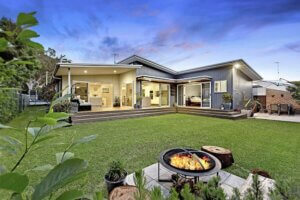When building in Australia, your house framing options are between steel and timber frames and trusses, which both have unique advantages and disadvantages.
For this article, we caught up with Gavin Sharpe from Australian Steel Framing in Berkley Vale on the Central Coast of NSW.
Australian Steel Framing is Newcastle and Central Coast’s leading steel frame supplier and manufacturer who design and fabricate lightweight steel frames and steel trusses made from 0.55mm – 1.2mm Bluescope TRUESCORE® Steel.
According to Gavin, the frame of a building is its backbone, so it must be both safe and secure. When choosing between either timber framing or steel framing, Gavin says you should consider the following:
- Cost of materials and labour
- The longevity of the finished product
- Any warranties
- Environmental sustainability
- What will best suit your site
- Any unique ecological factors like fire, storm and corrosion
- Flexibility and ability to make changes during the build phase
Below are Gavin’s pros and cons of building with Timber Framing and Steel Frames:
TIMBER HOUSE FRAMES
Timber house frames are Australia’s most popular choice of frame and truss. You don’t need research to prove that timber frames work. Hundreds of years of building history will prove that.
Here is a list of the associated Pros and Cons of timber frames:
Readily Available
Generally, timber framing can be easily sourced from any local hardware or building supplies store. Meaning framing can usually be constructed quickly on site. However, because timber frame building occurs on-site, there may be errors, creating waste and increasing labour costs.
Ease Of Use
Gavin says nearly all builders are very familiar and experienced with building framing out of timber. Timber can easily be cut to size on-site, and on-the-fly changes to your plan can be accommodated.
Renewable Resource
Timber is both a renewable resource and a natural product, making it environmentally friendly. Particularly timber sourced from sustainable and ethically sourced suppliers.
Natural Insulator
Timber will gather heat during the day and slowly release that heat throughout the night.
Disadvantages
While the initial cost for the timber to construct the frame is cheaper than steel, the construction process takes place on-site. All wood needs to be measured and cut to size, as opposed to steel framing that comes prefabricated chiefly off-site and ready for the erection upon delivery.
The other main deterrent to using timber framing is its susceptibility to pests and the elements such as fire, wind and storm. Any number of pests can compromise the integrity of the timber. That ranges from termites, borers, and vermin to possums. Wood is a lot easier to chew through than steel!
Lastly, timber is susceptible to moisture. As the wood absorbs water, it expands and contracts as it dries out. This expansion and contraction can cause the attached coverings, such as your gyprock and cornice, to warp and crack over time. It can be a breeding ground for mould and fungi, which pose significant health risks.
While a building frame made from BlueScope’s TRUECORE® steel is strong, straight and precise, won’t twist or warp over time and won’t catch fire, says Gavin.
STEEL FRAMES
According to Gavin, choosing steel frames and trusses benefits builders, designers and homeowners. Here is a list of his associated Pros and Cons of steel frames:
Weight & Strength
A steel-framed house is generally lighter than a house framed out of timber; steel has the highest strength-to-weight ratio of any material used in construction. Steel has the highest strength-to-weight ratio of any current residential building material. This high strength-to-weight ratio means steel components are more robust without adding weight. Steel frames and trusses provide a strong foundation for your home with no risk of warping or flexing.
Build Efficiency
Gavin says steel frames and trusses are pre-engineered to an exact design at their factory and then shipped out, ready for construction. This prefabrication significantly speeds up the building process, saving time and money in labour costs.
Pest Resistant
Steel is 100% resistant to pests such as termites and borers making it a reliable choice for your building.
Durability
Steel Framing offers unsurpassed durability when compared with Timber frames. It won’t warp or flex as timber does, meaning the lines of your building remain straight and accurate over time.
Gavin says eligible applicants who build with frames made from TRUECORE® Steel will get the reassurance of a staggering 50-year warranty.
Fire Resistant
Steel is 100% non-combustible, making it the logical building material for bushfire-prone areas.
Environmentally Sound
Steel Framing can earn builders points towards green certification programs. A quality Australian Steel Frame can create an airtight, well-insulated, energy-efficient home.
Disadvantages
Typically cost is seen as the main disadvantage of building with a steel frame, and there is an element of truth to this assumption as the raw cost of steel is more expensive than timber. However, due to the precision and accuracy of the prefabrication, assembly time is significantly reduced, meaning you will save thousands on labour costs and decrease the overall build time. The durability of steel will save you maintenance and repair costs. Insurance costs are also, in many cases, lower for homes with steel frame construction.
The main disadvantage is the environmental cost in terms of energy consumption to produce steel.
There you have it! Thanks for the great insights Gavin.
Both Steel and Timber framing have their unique advantages and disadvantages. If you’re considering building a new house, we would be happy to discuss your options further. Don’t hesitate to contact the Broadworth team today!





